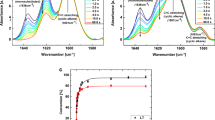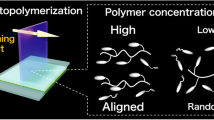Abstract
Morphology is the decisive factor controlling practical properties such as impact strength or transparency in multiphase polymeric materials1. The co-continuous structure formed by polymers has been of great interest to material scientists because of their superiority over those with random morphology2,3. Although a number of efforts—including forcibly freezing the spinodal structure of polymer blends—have been made to produce materials with co-continuous structures4,5, an efficient method for controlling their regularity is still lacking. Here, we demonstrate a novel method using periodic photo-crosslinking to control the length-scale distribution of the spinodal structure in binary polymer blends. It was found that the period distribution of the resulting co-continuous structure became significantly narrow under this periodic forcing. Also, there exists a particular irradiation frequency at which the periodic structure exhibits a minimum, indicating the existence of an ordering process driven by the external modulation frequency. Our findings reveal an easy way to produce polymer materials that is not only useful for optical applications, but also promising for biological separation, such as hemodialysis.
This is a preview of subscription content, access via your institution
Access options
Subscribe to this journal
Receive 12 print issues and online access
$259.00 per year
only $21.58 per issue
Buy this article
- Purchase on Springer Link
- Instant access to full article PDF
Prices may be subject to local taxes which are calculated during checkout




Similar content being viewed by others
References
Araki Tran-Cong, Q. & Shibayama, M. Structure and Properties of Multiphase Polymeric Materials (Marcel-Dekker, New York, 1998).
Hsu, W.Y. & Wu, S. Percolation behavior in morphology and modulus of polymer blends. Polym. Eng. Sci. 33, 293–302 (1993).
Cirkel, P.A. & Okada, T. A comparison of mechanical and electrical percolation during gelling of Nafion solutions. Macromolecules 33, 4921–4925 (2000).
Yamanaka, K., Takagi, Y. & Inoue, T. Reaction-induced phase separation in rubber-modified epoxy resins. Polymer 30, 1839–1844 (1989).
Tran-Cong, Q., Nagaki, T., Nakagawa, T., Yano, O. & Soen, T. Immobilization of transient structures in polystyrene/poly(2-chlorostyrene) blends undergoing phase separation by using photo-cross-linking. Macromolecules 22, 2720–2723 (1989).
Bansil, R. & Liao, G. Kinetics of spinodal decomposition in homopolymer solutions and gels. Trends Polym. Sci. 5, 146–154 (1997).
Kapral, R. & Showalter, K. Chemical Waves and Patterns (Kluwer Academic, Boston, 1995).
Glotzer, S.C., Di Marzio, E.A. & Muthukumar, M. Reaction-controlled morphology of phase-separating mixtures. Phys. Rev. Lett. 74, 2034–2037 (1995).
Carati, D. & Lefever, R. Chemical freezing of phase separation in immiscible binary mixtures. Phys. Rev. E 56, 3127–3137 (1997).
Tran-Cong, Q., Kawai, J. & Endoh, K. Mode selection in polymer mixtures undergoing phase separation by photochemical reactions. Chaos 9, 298–307 (1999).
Richert, R. & Blumen, A. (eds) Disorder Effects on Relaxational Processes (Springer, Berlin, 1994).
Onuki, A. & Taniguchi, T. Viscoelastic effects in early stage phase separation in polymeric systems. J. Chem. Phys. 106, 5761–5770 (1997).
Toyoda, N., Takenaka, M., Saito, S. & Hashimoto, T. Experimental studies of stress-diffusion coupling in semi-dilute polymer solutions. I. Polymer 42, 9193–9203 (2001).
Tanaka, H. Viscoelastic phase separation J. Phys. Condens. Matter 12, R207–R264 (2000).
Acknowledgements
This work was financially supported by the Ministry of Education, Japan (MONKASHO) through a grant-in-aid No.13031054.
Author information
Authors and Affiliations
Corresponding author
Ethics declarations
Competing interests
The authors declare no competing financial interests.
Supplementary information
Supplementary Information, Fig. A
Supplementary Information, Fig. B (PDF 608 kb)
Supplementary Information, Fig. C
Supplementary Information, Fig. D
Supplementary Information, Fig. E
Supplementary Information, Fig. F
Rights and permissions
About this article
Cite this article
Tran-Cong-Miyata, Q., Nishigami, S., Ito, T. et al. Controlling the morphology of polymer blends using periodic irradiation. Nature Mater 3, 448–451 (2004). https://doi.org/10.1038/nmat1150
Received:
Accepted:
Published:
Issue Date:
DOI: https://doi.org/10.1038/nmat1150
This article is cited by
-
Influence of phase-separated structural morphologies on the piezo and triboelectric properties of polymer composites
Discover Nano (2023)
-
TiO2 nanoparticles assembled on kaolinites with different morphologies for efficient photocatalytic performance
Scientific Reports (2018)
-
Morphological controlled synthesis of micro-/nano-polyaniline
Journal of Polymer Research (2011)
-
Synthesis of ordered spiral and ring-like polypyrrole nanowires in cetyltrimethylammounium bromide crystalline suspension
Colloid and Polymer Science (2009)



